Six is Enough
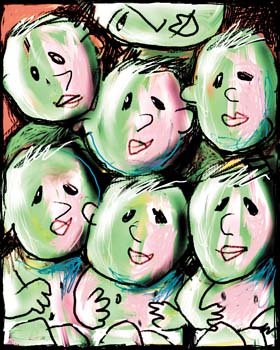 Around noon on April 6, (2002) 4-year-old Aubrianna, who had been summoned by her parents, Eldon fs ’02 and Sondra Headrick, from a visit to the zoo with her aunt, climbed onto her mom’s hospital bed at Via Christi Regional Medical Center-St. Joseph Campus in Wichita and announced, “We’re going to have six babies today!” And by 2:30 that afternoon, Sondra — who, with the help of her doctors and support of her family, had managed to stretch out her pregnancy to 31 weeks, the longest anyone has carried sextuplets in the United States — gave birth to Ethan Roy, Melissa Sue, Grant Douglas, Sean Edward, Jaycie Linette and Danielle Patrice.
Around noon on April 6, (2002) 4-year-old Aubrianna, who had been summoned by her parents, Eldon fs ’02 and Sondra Headrick, from a visit to the zoo with her aunt, climbed onto her mom’s hospital bed at Via Christi Regional Medical Center-St. Joseph Campus in Wichita and announced, “We’re going to have six babies today!” And by 2:30 that afternoon, Sondra — who, with the help of her doctors and support of her family, had managed to stretch out her pregnancy to 31 weeks, the longest anyone has carried sextuplets in the United States — gave birth to Ethan Roy, Melissa Sue, Grant Douglas, Sean Edward, Jaycie Linette and Danielle Patrice.
High Spirits
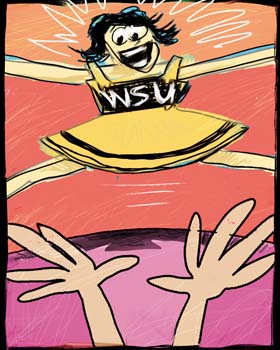 Even though National Center for Catastrophic Sports Injury Research deems collegiate cheerleading as among the most dangerous of sports, tenuousness and timidity were the furthest things from the minds of the 12 men and eight women who competed in the Cheer Nationals this April at Daytona Beach, Fla. Coached by Jay Grayson, the WSU Spirit Squad out-cheered, out-jumped, out-tossed and out-tumbled 375 other squads to take fifth place in the national competition.
Even though National Center for Catastrophic Sports Injury Research deems collegiate cheerleading as among the most dangerous of sports, tenuousness and timidity were the furthest things from the minds of the 12 men and eight women who competed in the Cheer Nationals this April at Daytona Beach, Fla. Coached by Jay Grayson, the WSU Spirit Squad out-cheered, out-jumped, out-tossed and out-tumbled 375 other squads to take fifth place in the national competition.
Introducing … Wheatman!
 There’s Superman, and there’s Spiderman, of course. Why not Wheatman? After all, John Carter from WSU’s College of Health Professions toils long hours in the service of protecting humankind. Since 1999, Carter, an associate professor of physical therapy, has been studying the health benefits of wheat in a joint research enterprise with sidekicks from Kansas State. To date, they’ve evaluated 70 strains of wheat and selected five for further research into which type best helps lower he risk of colon cancer. Colon cancer is the second leading cause of cancer deaths in the United States. This summer, Carter and crew will feed WSU lab mice suffering from intestinal tumors Kansas-grown, hard red winter wheat in various concentrations to test which mixture produces the best results in slowing and reducing tumor growth. The long-range goal is to breed modified wheat strains with the most effective protective qualities.
There’s Superman, and there’s Spiderman, of course. Why not Wheatman? After all, John Carter from WSU’s College of Health Professions toils long hours in the service of protecting humankind. Since 1999, Carter, an associate professor of physical therapy, has been studying the health benefits of wheat in a joint research enterprise with sidekicks from Kansas State. To date, they’ve evaluated 70 strains of wheat and selected five for further research into which type best helps lower he risk of colon cancer. Colon cancer is the second leading cause of cancer deaths in the United States. This summer, Carter and crew will feed WSU lab mice suffering from intestinal tumors Kansas-grown, hard red winter wheat in various concentrations to test which mixture produces the best results in slowing and reducing tumor growth. The long-range goal is to breed modified wheat strains with the most effective protective qualities.
Hats Galore
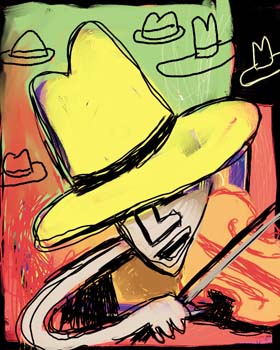 J.C. Combs, music professor and percussionist extraordinaire, has conducted many a bizarre combination of performers during the course of his renowned music career. (Remember those wrestlers?) But the April 31 (2002) concert of WSU’s student percussion ensemble, with a special performance by distinguished violinist and music professor John Harrison, was the first time hats were so prominently involved. There were hats on-stage, hats in the audience and videotaped hats. Even “Hatman Jack” Kellogg, owner of Wichita Hat Works, played a — what else? — hat salesman guiding such Shocker notables as Jim Rhatigan in their choice of the perfect hat.
J.C. Combs, music professor and percussionist extraordinaire, has conducted many a bizarre combination of performers during the course of his renowned music career. (Remember those wrestlers?) But the April 31 (2002) concert of WSU’s student percussion ensemble, with a special performance by distinguished violinist and music professor John Harrison, was the first time hats were so prominently involved. There were hats on-stage, hats in the audience and videotaped hats. Even “Hatman Jack” Kellogg, owner of Wichita Hat Works, played a — what else? — hat salesman guiding such Shocker notables as Jim Rhatigan in their choice of the perfect hat.
Man’s Best Friends
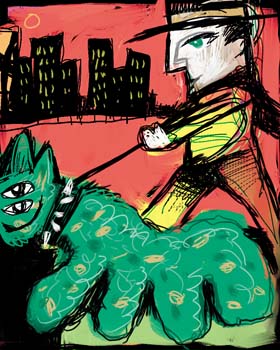 Not that cyanobacteria have quite the appeal of dogs, but many microbiologists do call the organisms “man’s best friends.” Mark Schneegurt, an assistant professor in biological sciences at Wichita State, even maintains a website dedicated to research about them: cyanosite.bio.purdue.edu. On the down side, cyanobacteria, or blue-green algae, are responsible for that foul-smelling scum that can invade ponds when, for instance, runoff from fertilized fields upsets the natural balance and produces an algae bloom. Blooms deplete the water’s oxygen, which can kill fish. Some of the cyanobacteria in these blooms may even produce toxins that can attack the liver or nervous systems if ingested. So why man’s best friends? “We wouldn’t be here, if it wasn’t for cyanobacteria,” Schneegurt explains. “There are a lot of things they do for us.” To mention only a few of their good-guy activities, cyanobacteria produce oxygen, and they take nitrogen gas from the air and make it into a usable form of biological nitrogen. Perhaps the oldest still-existing bacteria, they live in the coldest and hottest environments, including the most arid of deserts and within the ice and rocks of Antarctica.
Not that cyanobacteria have quite the appeal of dogs, but many microbiologists do call the organisms “man’s best friends.” Mark Schneegurt, an assistant professor in biological sciences at Wichita State, even maintains a website dedicated to research about them: cyanosite.bio.purdue.edu. On the down side, cyanobacteria, or blue-green algae, are responsible for that foul-smelling scum that can invade ponds when, for instance, runoff from fertilized fields upsets the natural balance and produces an algae bloom. Blooms deplete the water’s oxygen, which can kill fish. Some of the cyanobacteria in these blooms may even produce toxins that can attack the liver or nervous systems if ingested. So why man’s best friends? “We wouldn’t be here, if it wasn’t for cyanobacteria,” Schneegurt explains. “There are a lot of things they do for us.” To mention only a few of their good-guy activities, cyanobacteria produce oxygen, and they take nitrogen gas from the air and make it into a usable form of biological nitrogen. Perhaps the oldest still-existing bacteria, they live in the coldest and hottest environments, including the most arid of deserts and within the ice and rocks of Antarctica.
An Uplifting Sight
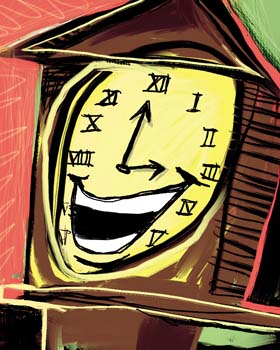 WSU’s distinctive Morrison Hall clock tower has had a facelift — a clock-facelift, to be exact. Designed to reflect Georgian architecture, the building was dedicated as a library in 1939. This June, scaffolding was erected around the tower so that four new clocks could be installed. The clocks, each of which is 6 feet in diameter, are dramatically backlit, making WSU’s signature image even more … uplifting.
WSU’s distinctive Morrison Hall clock tower has had a facelift — a clock-facelift, to be exact. Designed to reflect Georgian architecture, the building was dedicated as a library in 1939. This June, scaffolding was erected around the tower so that four new clocks could be installed. The clocks, each of which is 6 feet in diameter, are dramatically backlit, making WSU’s signature image even more … uplifting.





